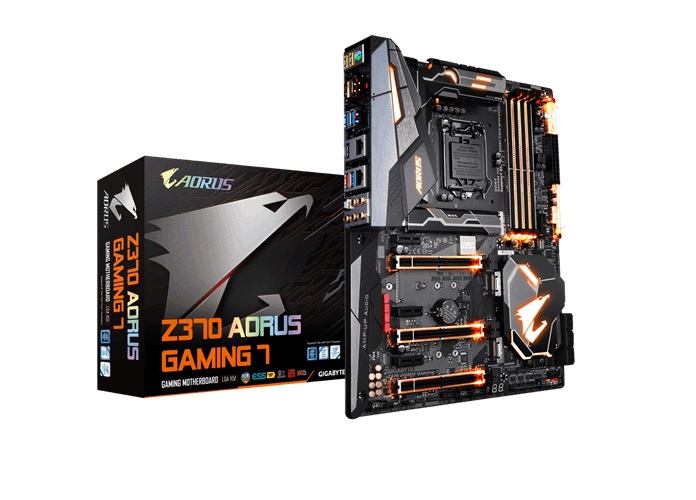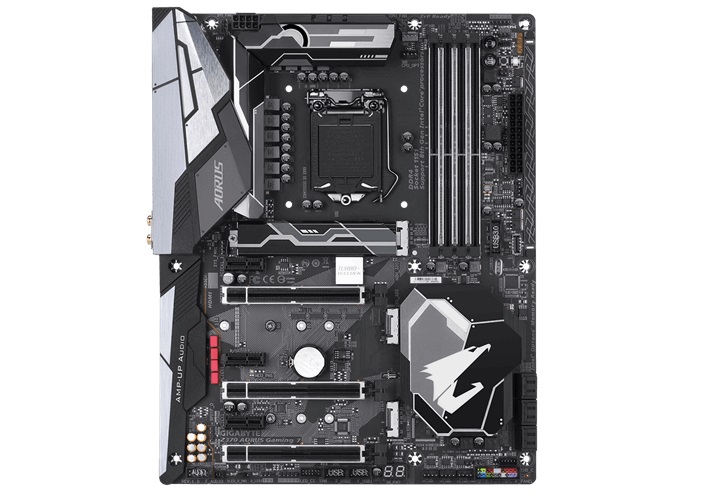Gigabyte Debuts Six New Aorus Z370 Motherboards
Gigabyte revealed six new Aorus-branded motherboards that are ready for Intel’s 8th generation desktop processors with minty-fresh Z370 chipsets onboard.
The new Gigabyte Aorus Ultra Gaming motherboards vary in features and connectivity, but all of them support the anticipated Intel Coffee Lake processors (and only 8th generation processors) and have an ATX form factor with four DDR4 memory DIMM slots capable of supporting up to 64GB (4 x 16GB) of dual-channel RAM. Memory speeds differ between the top-end boards and the rest of the lineup; the Aorus Gaming 7 and Gaming 5 support up to DDR4-4133 (O.C.), but the remaining Z370 offerings support up to DDR4-4000 (O.C.).
The Z370 Aorus Gaming motherboards all feature six SATA III (6Gbps) ports for storage (with support for RAID 0, 1, 5, and 10) and optical drives. Most of the boards sport two M.2 interfaces, with both supporting PCIe 3.0 x 4 devices and one of them capable of housing SATA M.2 SSDs (although the type and connectivity varies between models). However, the top end of the product stack (the Gaming 7 and Gaming 5) feature three M.2 interfaces, with two of the ports supporting SATA drives (all three support PCIe 3.0 x4 devices). All of the Aorus Z370 motherboards are also Intel Optane Memory ready.
The PCIe connectivity of the new Aorus Z270 motherboards is varied, with four of the boards (Gaming 7, Gaming 5, Ultra Gaming, and Gaming Wifi) offering enough PCIe lanes for SLI or triple CrossFire setups. These boards all sport three PCIe x16 slots, with the top two slots splitting 16 lanes between them (x16 for single GPUs, x8/x8 for dual GPUs, x8/x8/x4 for triple-card setups). The other new Z270 motherboards (Gaming 3, Gaming K3) are aimed at a more budget-oriented gamer, dropping one of the x16 slots (for a total of only two) and allocating 16 lanes to just one of the slots, giving the second slot only 4 PCIe 3.0 lanes. Although this is still suitable for AMD Crossfire setups, SLI is out (you need at least two slots with 8 lanes each for dual-GPU Nvidia configurations).
Each of the new Aorus Z270 motherboards sport a healthy amount of USB connectivity, with all of them featuring a USB 3.1 Gen 2 Type-C and Type-A port (one of each). The majority of the boards (Gaming 5, Gaming Ultra, Gaming 3, Gaming K3) also sport four USB 3.1 Gen 1 ports and two USB 2.0 ports. The Aorus Gaming 7 lacks the USB 2.0 ports, but it has five USB 3.1 Gen 1 ports. The Gaming Wifi motherboard also sheds the USB 2.0 back panel connections, but it bolsters its total connectivity with six USB 3.1 Gen 1 ports.
The display output options between the different motherboards are different, but there are three different combinations of ports across the lineup. The Gaming 7 and Gaming 5 both sport a DisplayPort 1.2 and HDMI 1.4 interface. The Gaming Ultra and Gaming K3 feature a DVI-D and an HDMI 1.4 port, and the Gaming 3 and Gaming Wi-Fi only have a single HDMI 1.4 output.
Networking interfaces also vary across the new Aorus Z370 motherboards. Both the Gaming 5 and Gaming Wi-Fi feature Intel gigabit LAN and Wireless AC 3165. The top-tier Gaming 7 features both Intel and Killer gigabit LAN (dual gigabit LAN), but it doesn’t have wireless connectivity. The Gaming 3 sports a Killer E2500 gigabit LAN port, and the Gaming K3 and Ultra Gaming each have a single Intel gigabit LAN port.
Get Tom's Hardware's best news and in-depth reviews, straight to your inbox.
The new Aorus Gaming motherboards don’t stray too far from the previous chipset designs; the feature set is nearly identical to the Z270 predecessors, and the proprietary features (Ultra Durable PCIe and Memory Armor, RGB Fusion, for example) all remain a staple for the Aorus-branded boards.
There’s no word yet on pricing or when we’ll see the new Gigabyte Aorus Z370 motherboards, but we suspect that they’ll start hitting the market around October 5 to coincide with Intel’s CPU launch. We’d also wager that the new boards will fall into similar price points as its Z270 predecessors.
| Gigabyte Motherboard | Aorus Gaming 7 | Aorus Gaming 5 | Aorus Ultra Gaming | Aorus Gaming 3 | Aorus Gaming K3 | Aorus Gaming Wifi |
|---|---|---|---|---|---|---|
| Chipset | Intel Z370 | |||||
| Form Factor | ATX | |||||
| Memory Support | Up to 64GB (4 x 16GB) DDR4-4133 | Up to 64GB (4 x 16GB) DDR4-4000 | ||||
| Storage Interface | - M.2 (Type 22110, SATA/PCIe x4) x2- M.2 (Type 2280, PCIe x4)- SATA III (6Gbps) x6 | - M.2 (Type 22110, PCIe x4)- M.2 (type 2280, SATA/PCIe x4)- SATA III (6Gbps) x6 | - M.2 (Type 22110, SATA/PCIe x4)- M.2 (Type 2280, PCIe x4)- SATA III (6Gbps) x6 | |||
| PCIe Connectivity | - PCIe 3.0 x16- PCIe 3.0 x8- PCIe 3.0 x4- PCIe x1 (3) | - PCIe 3.0 x16- PCIe 3.0 x4- PCIe x1 (4) | - PCIe 3.0 x16- PCIe 3.0 x8- PCIe 3.0 x4- PCIe x1 (3) | |||
| Display Connectivity | -DisplayPort 1.2- HDMI 1.4 | -DisplayPort 1.2- HDMI 1.4 | - DVI-D- HDMI 1.4 | HDMI 1.4 | - DVI-D- HDMI 1.4 | HDMI 1.4 |
| USB Connectivity | - USB 3.1 Gen 2 Type-C - USB 3.1 Gen 2 Type-A- USB 3.1 Gen 1 x5 | - USB 3.1 Gen 2 Type-C - USB 3.1 Gen 2 Type-A- USB 3.1 Gen 1 x4- USB 2.0 x 2 | - USB 3.1 Gen 2 Type-C - USB 3.1 Gen 2 Type-A- USB 3.1 Gen 1 x4- USB 2.0 x 2 | - USB 3.1 Gen 2 Type-C - USB 3.1 Gen 2 Type-A- USB 3.1 Gen 1 x4- USB 2.0 x 2 | - USB 3.1 Gen 2 Type-C - USB 3.1 Gen 2 Type-A- USB 3.1 Gen 1 x4- USB 2.0 x 2 | - USB 3.1 Gen 2 Type-C - USB 3.1 Gen 2 Type-A- USB 3.1 Gen 1 x6 |
| PCIe Armor (Slot Brace) | Yes | |||||
| Memory Armor (Slot Brace) | Yes | No | ||||
| Networking | - Intel Gigabit LAN- Killer E2500 LAN | - Intel Gigabit LAN- Intel Wireless AC 3165 | Intel Gigabit LAN | Killer E2500 Gigabit LAN | Intel Gigabit LAN | - Intel Gigabit LAN- Intel Wireless AC 3165 |
Derek Forrest was a contributing freelance writer for Tom's Hardware. He covered hardware news and reviews, focusing on gaming desktops and laptops.
-
Lucky_SLS Few places u mention them as z270 instead of z370.Reply
Also, AMD dropped its crossfire branding didn't they? Aren't they now simply called multi gpu or mGPU support?


